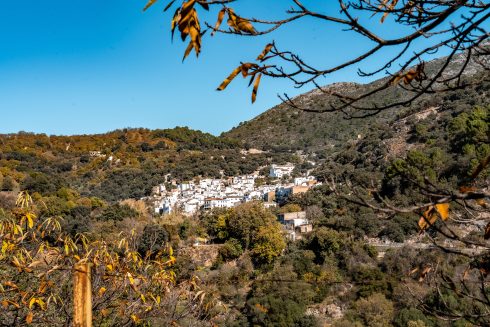AT first, Captain Sebastien Destremau believed a sudden incoming swell was just the fierce poniente wind blowing in from the Atlantic one afternoon in May – ‘as it can when you exit the Strait of Gibraltar.’
The garlanded French sailor, with multiple world championships and America’s Cups campaigns to his name, gave the order to drop the sail.
But when he turned his weather-beaten face to windward once more, he saw that it was not the famed Atlantic weather bringing in the onrushing waves.
Around 20 orcas – half of the total population of Iberian Orcas – were moving in towards his yacht, the 17-metre Lancelot, at tremendous speed.

Destremau was all too aware of this particular pod, which has made the Cadiz coast their stomping ground and the bluefin tuna their dish of choice.
Eight of the apex predators approached Destremau’s 15-tonne boat and spun it around ‘like a nutshell’ with incredibly powerful nudges to the rudder.
Despite the ordeal, Destremau did not feel he had been the target of orca wrath. “It would be so easy for these beasts to sink us if they wanted to.”
While the Lancelot could limp to port, three vessels have in fact been sunk by the Iberian orcas.
And dozens more have had to be rescued by maritime authorities.

These encounters, all taking place in or near the Strait of Gibraltar over the last three years, have baffled the scientists, marine biologists and animal behaviourists of the world.
Wild theories abound to explain the unprecedented behaviour, and there has been a proliferation of ‘melodramatic storylines.’
They range from orca anger at humans encroaching on their yard, to tales of an orca mother known as Black Gladys’ out for revenge after her child was killed by a yacht propeller.
Worried about the unintended consequences of these tales, a number of orca and cretecan experts put out an open letter in August seeking to debunk these ‘inappropriate’ narratives.
The signatories have called out such ‘anthropomorphistic theories’, which project ‘human motivations’ onto wild beasts.
They fear that such talk could provoke human retaliation.

Naomi Rose, marine mammal scientist for the Animal Welfare Institute, spearheaded the letter and was the first signatory.
Characterising the interactions as ‘attacks’ – implying aggression and hostility – is misleading, she told the Olive Press.
“And this whole myth around Black Gladys, is just that – a myth.”
However, like all myths, it originates from a grain of truth.
The few orcas that participate in the interactions with the boats have been given the designation ‘Gladys’ to differentiate them from pod members which don’t.
Rose admits it is a somewhat ‘unfortunate’ misnomer, as it comes from the Latin for ‘sword’, its root in English being ‘gladiator.’
But while it may be a mistake to project human attitudes onto orcas in one respect, in others they display behaviour that every human will recognise.
The leading theory for the orca behaviour is that it did in fact originate with a small group of juveniles, one of whom is indeed known as ‘Black Gladys’.
She was observed with a head laceration in the spring of 2020 and later was spotted with a wound behind the dorsal fin in 2021.

However, according to the experts, ‘Black Gladys’ is not the whale that started the interactions – nor is it known how she got her wounds.
It is simply not known why these young ones started bumping the boats.
But orcas, which are members of the dolphin family, are highly intelligent creatures known for their ‘cultural fads’.
So it is theorised that once these young trendsetters started off the ‘fad’, more of them decided to join in as a form of social interaction.
A previous ‘fad’ was observed in a pod of Pacific orcas off the coast in Washington in 1987, after they started to wear ‘salmon hats’ on their heads.
The bizarre sight was first observed in a single female orca, seen swimming with a dead salmon perched on her nose.
Soon, several others in her pod adopted this behaviour, and over the following weeks the trend even spread to other pods within the same community.
“It had no obvious biological significance to them,” Mark Simmonds, Director of Science at the non-profit OceanCare told the Olive Press.
“So we think that this is probably mainly a form of creative play behaviour and signalling to each other.
“The consensus is that they’re doing this to show off.

“In the same way, these particular orcas have discovered how to manipulate these boats, which is interesting, and in some ways, stimulating to them.”
However, just like Tamagotchis, the Harlem Shake and the Ice Bucket Challenge, the salmon hat was all the rage for five to six weeks and then it suddenly died out.
Rose’s greatest fear, if this fad doesn’t similarly die out, is that eventually a human might get hurt or even drown.
So far, no sailors have found themselves floating in the water with the world’s apex predator – which have never been known to deliberately attack a human in the wild.
But experts do not believe that this is due to an innate altruistic nature of the orca, which unlike dolphins or humpback whales, are not known to help other species in danger.
“I would never ever, after hundreds of hours on the water watching and studying these guys, swim with them in the wild,” Rose warned.
“It’s stupid as hell – they’ve got big teeth.
“They are smart and they sometimes decide to play with not only their food, but with other mammals. “They’ve never harmed a human but there’s not some orca law forbidding it.”
What worries Rose is that boat and human interactions are losing their novelty for the wild animals, which tend to shun things they don’t know.
With increased human interactions comes decreased fear – and the increased possibility that an orca might decide to ‘play’ with a human.
And what measures might authorities take against the Iberian orca in return – a critically endangered species – if they view them as dangerous and threatening?
In August, footage emerged of crew on a sailboat shooting at the Gladys orcas with an air rifle and even throwing firecrackers overboard.
Yachties have been trialling all sorts of methods to protect their boats, from chucking sand over the side when the creatures come near, to blasting out heavy metal under water.
“We think they could be vulnerable to acoustics, so people will be looking in that direction,” Simmonds theorised.
“But again, if an acoustic approach is used, it’s got to be something which is very carefully balanced so that it helps persuade them to go away and do something else with their time but doesn’t harm them.”
If such measures fail, and eventually someone is killed, Rose fears authorities will undertake a cull of the Iberian Orca.
“I’m very sympathetic to the mariners,” she said.
“Who wants their yacht sunk? But God – it’s just a yacht. These animals are a unique population.
“Do we really want to kill a bunch of endangered animals because our yachts are sinking?”
Click here to read more Animals News from The Olive Press.








